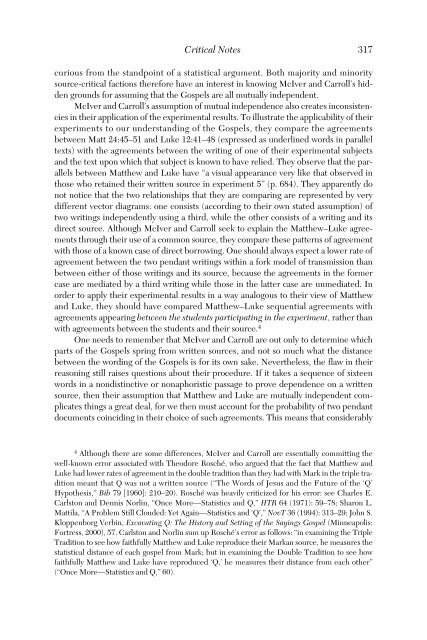Journal of Biblical Literature - Society of Biblical Literature
Journal of Biblical Literature - Society of Biblical Literature
Journal of Biblical Literature - Society of Biblical Literature
You also want an ePaper? Increase the reach of your titles
YUMPU automatically turns print PDFs into web optimized ePapers that Google loves.
Critical Notes 317<br />
curious from the standpoint <strong>of</strong> a statistical argument. Both majority and minority<br />
source-critical factions therefore have an interest in knowing McIver and Carroll’s hidden<br />
grounds for assuming that the Gospels are all mutually independent.<br />
McIver and Carroll’s assumption <strong>of</strong> mutual independence also creates inconsistencies<br />
in their application <strong>of</strong> the experimental results. To illustrate the applicability <strong>of</strong> their<br />
experiments to our understanding <strong>of</strong> the Gospels, they compare the agreements<br />
between Matt 24:45–51 and Luke 12:41–48 (expressed as underlined words in parallel<br />
texts) with the agreements between the writing <strong>of</strong> one <strong>of</strong> their experimental subjects<br />
and the text upon which that subject is known to have relied. They observe that the parallels<br />
between Matthew and Luke have “a visual appearance very like that observed in<br />
those who retained their written source in experiment 5” (p. 684). They apparently do<br />
not notice that the two relationships that they are comparing are represented by very<br />
different vector diagrams: one consists (according to their own stated assumption) <strong>of</strong><br />
two writings independently using a third, while the other consists <strong>of</strong> a writing and its<br />
direct source. Although McIver and Carroll seek to explain the Matthew–Luke agreements<br />
through their use <strong>of</strong> a common source, they compare these patterns <strong>of</strong> agreement<br />
with those <strong>of</strong> a known case <strong>of</strong> direct borrowing. One should always expect a lower rate <strong>of</strong><br />
agreement between the two pendant writings within a fork model <strong>of</strong> transmission than<br />
between either <strong>of</strong> those writings and its source, because the agreements in the former<br />
case are mediated by a third writing while those in the latter case are unmediated. In<br />
order to apply their experimental results in a way analogous to their view <strong>of</strong> Matthew<br />
and Luke, they should have compared Matthew–Luke sequential agreements with<br />
agreements appearing between the students participating in the experiment, rather than<br />
with agreements between the students and their source. 4<br />
One needs to remember that McIver and Carroll are out only to determine which<br />
parts <strong>of</strong> the Gospels spring from written sources, and not so much what the distance<br />
between the wording <strong>of</strong> the Gospels is for its own sake. Nevertheless, the flaw in their<br />
reasoning still raises questions about their procedure. If it takes a sequence <strong>of</strong> sixteen<br />
words in a nondistinctive or nonaphoristic passage to prove dependence on a written<br />
source, then their assumption that Matthew and Luke are mutually independent complicates<br />
things a great deal, for we then must account for the probability <strong>of</strong> two pendant<br />
documents coinciding in their choice <strong>of</strong> such agreements. This means that considerably<br />
4 Although there are some differences, McIver and Carroll are essentially committing the<br />
well-known error associated with Theodore Rosché, who argued that the fact that Matthew and<br />
Luke had lower rates <strong>of</strong> agreement in the double tradition than they had with Mark in the triple tradition<br />
meant that Q was not a written source (“The Words <strong>of</strong> Jesus and the Future <strong>of</strong> the ‘Q’<br />
Hypothesis,” Bib 79 [1960]: 210–20). Rosché was heavily criticized for his error: see Charles E.<br />
Carlston and Dennis Norlin, “Once More—Statistics and Q,” HTR 64 (1971): 59–78; Sharon L.<br />
Mattila, “A Problem Still Clouded: Yet Again—Statistics and ‘Q’,” NovT 36 (1994): 313–29; John S.<br />
Kloppenborg Verbin, Excavating Q: The History and Setting <strong>of</strong> the Sayings Gospel (Minneapolis:<br />
Fortress, 2000), 57. Carlston and Norlin sum up Rosché’s error as follows: “in examining the Triple<br />
Tradition to see how faithfully Matthew and Luke reproduce their Markan source, he measures the<br />
statistical distance <strong>of</strong> each gospel from Mark; but in examining the Double Tradition to see how<br />
faithfully Matthew and Luke have reproduced ‘Q,’ he measures their distance from each other”<br />
(“Once More—Statistics and Q,” 60).

















